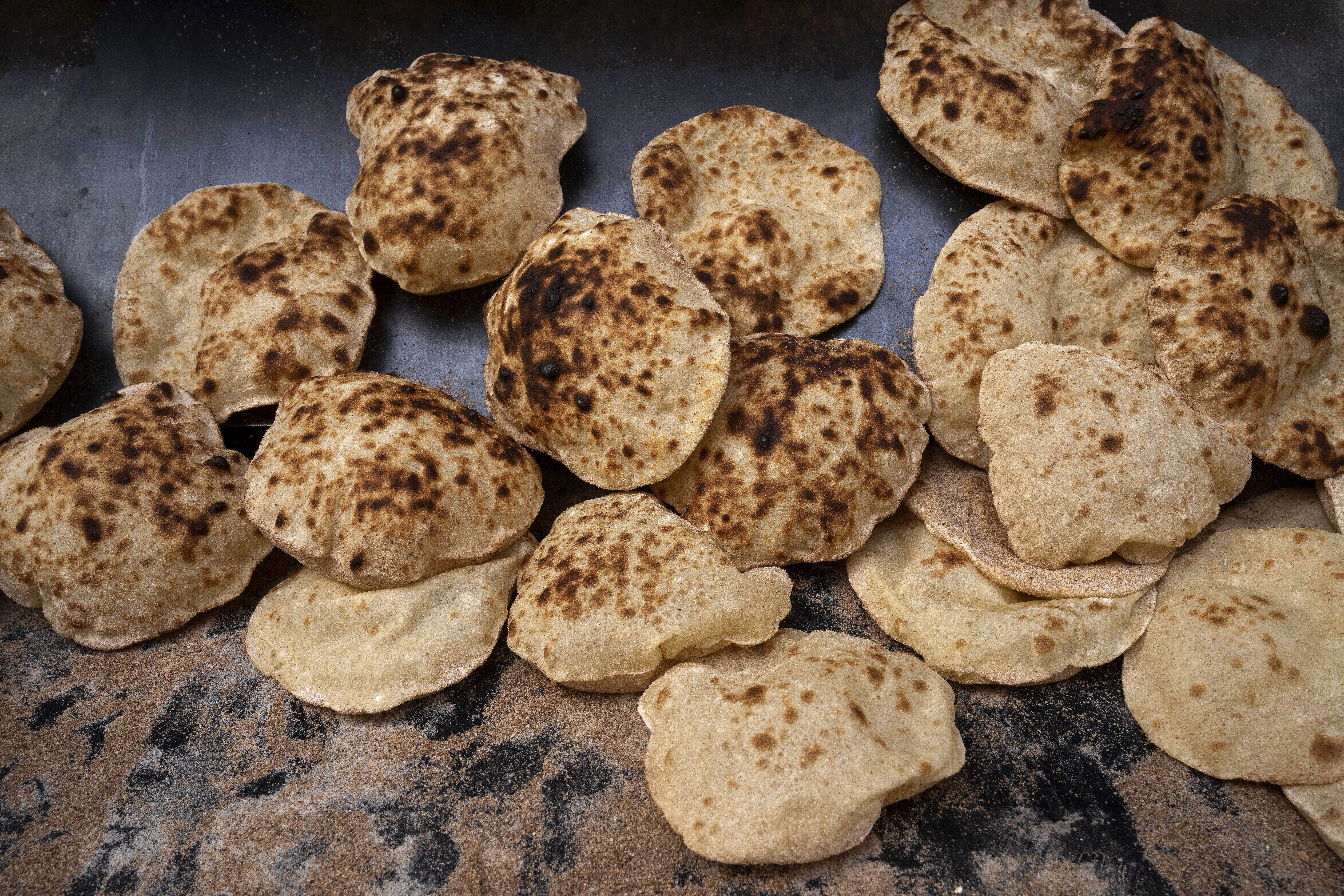This website uses cookies so that we can provide you with the best user experience possible. Cookie information is stored in your browser and performs functions such as recognising you when you return to our website and helping our team to understand which sections of the website you find most interesting and useful.
Press play to listen to this article
Guess from where the U.N. World Food Programme sourced more than half of its supplies for the hungry across the globe in 2021? Yes, Ukraine.
When this "breadbasket of Europe" is knocked out of supply chains and aid networks, the world is going to feel it.
The war between Russia and Ukraine, both food-producing powerhouses, has already sent prices for cereals like wheat soaring and European governments scrambling to stabilize markets.
Europe can probably weather the immediate storm. Its farmers are bracing for even higher costs of basic inputs like fertilizers and animal feed, but consumers are unlikely to see empty supermarket shelves. Costs will go up — particularly for key goods like sunflower oil — but rich Western economies can afford to diversify.
The picture is more alarming in the developing world, where countries especially in the Middle East and North Africa — already stricken by droughts — could face much higher prices for basic foodstuffs like bread. And if people go hungry or can't feed their families, political instability would likely follow.
Here are the top five impacts the crisis is having on the world food system.
1. Soaring food prices
Ukraine is a gigantic exporter of commodities like wheat, corn and sunflower oil but Russia’s invasion means all trade has stopped because ships cannot leave Black Sea ports.
That is already having a major impact, with the price of grain and oilseeds surging to record highs as traders worry about how long this disruption will last. “In the worst case scenario, there’s going to be no export from this region for a couple of years,” said Oleg Nivievskyi, assistant professor at the Kyiv School of Economics.
Though politicians have been careful to state there are no impending food shortages in Europe, Ukraine is nonetheless the EU’s fourth biggest external provider of food, acting like an enormous vegetable patch. The EU gets over half its corn imports, around a fifth of its soft wheat imports, and almost a quarter of its vegetable oil imports from Ukraine.
These supply problems with Ukraine and Russia are an almighty headache for those making or growing food in the EU, who were already feeling the bite of energy price rises and COVID-related inflation. With prices of food products soaring, it will be more expensive for EU food processors to get hold of raw ingredients, while Europe’s farmers are set to pay even more for fertilizers to keep their yields high. The price of fertilizers — 30 percent of EU imports come from Russia — has already rocketed by 142 percent compared with this time last year.
This is all grimly ironic since EU farmers have for years complained about Ukrainian exports being too successful. They have typically viewed Ukraine as a Brazil on their doorstep, able to undercut them by flooding the EU market with cheaply produced food. Just months ago, France’s Agriculture Minister Julien Denormandie name-checked Ukraine when trumpeting a new national labeling rule that will help restaurant diners tell if the chicken on their plates comes from France or elsewhere.
2. Fears of famine
In turn, skyrocketing grain prices are sparking broader fears that millions of the world’s poorest people will struggle to feed themselves.
In the immediate crisis zone are countries that are staggeringly dependent on Ukraine and Russia, like Egypt, Tunisia, Algeria, Morocco, Lebanon and Turkey. A stunning 48 percent of wheat imports to Algeria come from Ukraine, according to Gallup research. Those countries will have to turn to other exporting nations to buy grains, further pushing up global prices.
The two warring countries are cereal heavyweights, accounting for 29 percent of the global wheat exports, and bread is a staple food in many of the poor countries they provide with food. As for Russia, nobody knows whether Moscow will want to keep exporting as much food as before or restrict flows, especially when its own hungry population is facing sanctions.
But it’s not just the countries directly dependent on Ukraine or Russia that have reason to worry. Rising food prices globally will impact all the poorest, and least food-secure countries, from Bangladesh and Madagascar to Yemen. Grain prices soared by 50 percent in the first two weeks of the conflict, according to Matin Qaim, professor of agricultural economics at the University of Bonn. He explained that as traders try to substitute crops like wheat with others like rice or barley, global commodity prices are rising across the board.
Aid agencies will likely see the money they fundraise not going as far. "We plan our procurement months in advance, so we’re not looking at immediate impacts of our other operations, but price increases we feel right away, transport costs we feel,” said Jordan Cox, head of communications for the U.N. World Food Programme, which has branded 2022 "a year of catastrophic hunger."
Political upheaval follows hard on the heels of food shortages, and many analysts have pointed out the role of food shortages as a factor in the Arab Spring revolutions a decade ago.
When it comes to political problems, Qaim said: “The likelihood of this happening is very high and it’s already starting.”
European Agriculture Commissioner Janusz Wojciechowski has warned a food crisis further afield could “increase the migration pressure on Europe.”
The next big test for the world’s food security will come in the summer when, just like in the EU, Ukrainian farmers harvest their crops. If they’ve been fighting on the front lines — or have lost their farmlands entirely — the outlook could be bleak. It’s too early to say if those crops can even be planted this spring: “Because of this fighting and this situation, nobody knows what’s going to happen,” said Nivievskyi from the Kyiv School of Economics.
3. Rising protectionism
What happens when you are a politician and you start worrying you won't be able to feed your population? You shut the borders, stockpile food and stop anyone from exporting. Fears about hoarding and trade ructions are rising. G7 ministers rallied last week to send an urgent message about the importance of not imposing trade barriers at a time of severe market turbulence.
But not everyone is listening. Hungary has slapped extra controls on grain exports, while claiming the move is not a fully fledged export ban, and it has drawn stern condemnation from the European Commission. Meanwhile, Turkey, Argentina and Serbia — plus Ukraine and Russia themselves — have also imposed, or threatened to impose, export bans.
Everything’s connected. “If major exporters are doing that then the prices in the rest of the world on the international markets are increasing much more and that’s hurting the food-import dependent countries,” said Qaim from the University of Bonn.
U.S. officials are worried that China is strategically hoarding food in order to have greater political leverage over food import-dependent countries in Africa.
Meanwhile, France has seized upon the crisis to argue it was right all along to pursue its “food sovereignty” agenda of beefing up the European Union’s ability to feed itself using internal resources, rather than relying on all that animal feed from Ukraine, Brazilian soybeans and Russian nitrogen-based fertilizers. Economy Minister Bruno Le Maire said this week: “All the French strategic intuitions about energy independence and food independence are validated by the consequences of the war.”
In the text of a declaration EU leaders inked at a meeting in Versailles last week, they pledged to boost the bloc’s own production of plant proteins — a traditional weak point of the EU’s heavily subsidized agricultural system.
4. Green dreams dashed
The war in Ukraine could mean dialing back Europe’s big ambitions to make farming clean up its impact on the climate and the environment.
Less corn from Ukraine means less feed for Europe’s animals this year, and higher animal feed prices for Europe’s farmers, who are already struggling to make ends meet. A lot of that Ukrainian fodder traditionally comes via Black Sea ports that are now blocked.
Fears of looming feed shortages have fueled calls to delay or even entirely rethink the EU’s landmark sustainability plans for the agriculture sector. The European Commission is considering a proposal from a majority of EU farming ministers to temporarily scrap the requirement to leave a chunk of farmland out of production to help boost nature protection, and instead use it to grow animal feed.
But this has drawn stinging attacks from Greens, who argue this is an ideal opportunity to reduce the amount of resources handed over to the meat and dairy industries.
The Commission's stated plans to think about propping up the (not-so-green) pig sector — one of the major industries being squeezed by the rising price of grains — has also prompted a backlash, including from more economically liberal Nordic countries.
5. Sunflower shutdown
The EU imports half of Ukraine’s production of sunflower oil, which can be found in everything from baked, canned and pre-made foods, to spreads, sauces and soups. It is also widely used in confectionary products and is an ingredient that is difficult to replace in baby food.
“It will obviously cause supply disruptions because we are dependent on rather regular supplies of Ukrainian sunflower seed oil to Europe,” said Nathalie Lecocq, director general of FEDIOL, the umbrella association for EU vegetable oil refiners that supply the food industry. “At this point, we are really concerned about availability.”
Rubén Moreno, head of Spanish confectionary industry group Produlce, said their stocks are at risk of running out in as little as two to three weeks, and warned that the “extreme relevance” of Ukraine as a global sunflower oil provider meant repercussions would extend far beyond the Spanish sweets and bakery sector.
“We are in a situation where the entire European and global food industry are fighting for the sunflower oil supplies that remain,” he said, adding that while the search for alternative oils was on, “it would not suffice to make up for the loss of Ukrainian oil.”
The restaurant and food service industries are also on the front lines here, as they rely on sunflower oil to cook and fry their meals. Arnaud Dufour, head of Serving Europe, which represents fast food chains like McDonald’s, Starbucks and Burger King, said sunflower oil would be where most restaurants would feel the first hit, with poultry meat likely to come next, due to the rise of animal feed prices.
As the industry scrambles to find alternatives in order to keep supermarket shelves stocked, the costs of product reformulation and adapting ingredient labels are likely to be passed on to consumers. But with record food inflation already squeezing household budgets, consumer defense groups are also warning retailers not to fuel fears of shortages and artificially bump up prices.
“We think there is no reason to increase the price of oil already on the shelves, given it was bought at a stable price,” said Ileana Izverniceanu from Spanish consumer lobby OCU. “The war in Ukraine must not be an excuse to hike prices” or to stoke fears over shortages and trigger stockpiling, she added.

This article is part of POLITICO Pro

The one-stop-shop solution for policy professionals fusing the depth of POLITICO journalism with the power of technology
Exclusive, breaking scoops and insights
Customized policy intelligence platform
A high-level public affairs network




 Africana55 Radio
Africana55 Radio 

